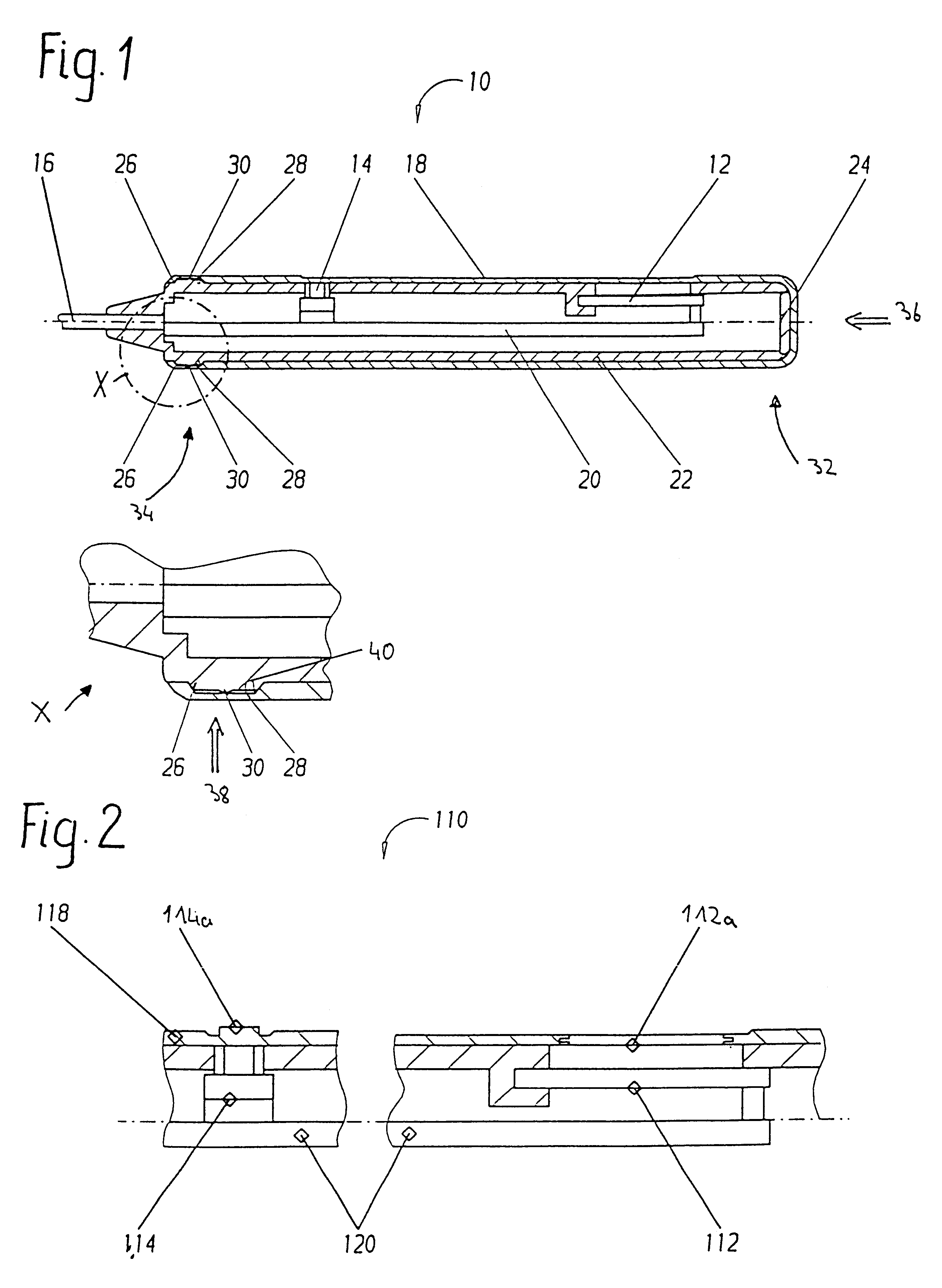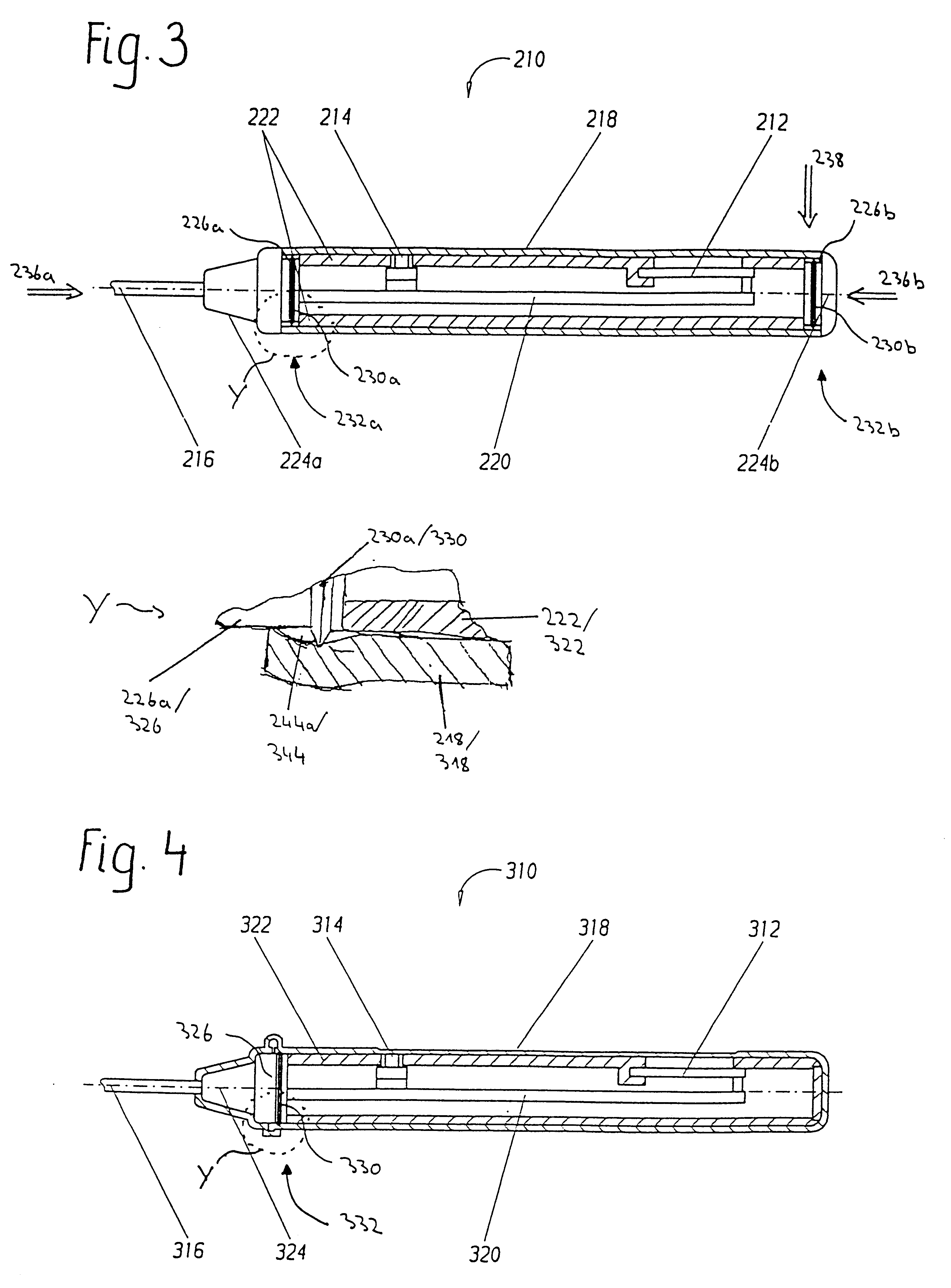Control and display device
- Summary
- Abstract
- Description
- Claims
- Application Information
AI Technical Summary
Benefits of technology
Problems solved by technology
Method used
Image
Examples
first embodiment
Referring to FIG. 1, shown is an example of a cross-section of a measuring instrument 10. Instrument 10 has, in the embodiment illustrated, a single housing 18, which has an essentially U-shaped cross section and accommodates an also essentially U-shaped sleeve 22 so that the end of sleeve 22, open on one side, is located on base 32 of housing 18. The end of sleeve 22, open on one side, is closed by a cover 24. A measuring sensor 16 protrudes from sleeve 22 on the side of sleeve 22 facing away from cover 24 and base 32. In the present embodiment, sensor 16 is designed as a probe tube for temperature measurement, but sensor 16 may also be designed in any other manner, for example, as a hygrometer probe, ampere meter, ohmmeter, pressure gauge probe, and the like.
A circuit board 20 having an indicator panel 12 and coupled to a keyboard 14 via contact-sensitive areas on circuit board 20, is provided within sleeve 22.
Indicator panel 12 may be designed as a display, for example, which is ...
second embodiment
FIG. 2 is an example of a cross section of details of an embodiment of an indicator area and a keyboard area of a measuring instrument. The same reference symbols, increased by 100, are used for the same elements and parts or those having the same function as in FIG. 1.
Instrument 110, shown in partial cross section in FIG. 2, also includes a housing 118, having an indicator panel 112, a keyboard 114, a circuit board 120, and a sleeve 122. Housing 118 has, in the area of the control panel, push rods 114a, each of which is assigned to a key of keyboard 114. These push rods 114a raise over the outer area of housing 118. In order to ensure simple actuation of keyboard 114, housing 118 in this embodiment may have, in the area of keyboard 114, i.e., at the edge of push rods 114a, a reduced wall thickness, so that this area of housing 118 can be easily elastically deformed, for example, with a finger tip or a rod for actuating the keys.
In contrast to the first embodiment according to FIG. ...
third embodiment
FIG. 3 is an example of measuring instrument 210. Identical element and parts or those having identical functions, are identified by reference numbers increased by 200 compared to those of FIG. 1.
With respect to the previously described embodiments set forth herein, a difference with reference to the embodiment of FIG. 3 is that housing 218 is provided with open end faces 232a, 232b arranged opposite each other. Each of these end faces 232a, 232b may be closed by a cover, respectively, 224a, 224b. A sensor 216 may be arranged on one of these covers, such as 224a, for example. Furthermore, this measuring instrument 210 may also include the above-described components, namely an indicator panel 212, a keyboard 214, a circuit board 220, and a sleeve 222.
In FIG. 3, end areas 232a, 232b of housing 218 are sealed via sealing devices. The sealing devices, which here seal housing 218 at the two covers 224a, 224b, may include a fixed ring 226a, 226b, which are also attached to a cover 224a, 2...
PUM
 Login to View More
Login to View More Abstract
Description
Claims
Application Information
 Login to View More
Login to View More - R&D
- Intellectual Property
- Life Sciences
- Materials
- Tech Scout
- Unparalleled Data Quality
- Higher Quality Content
- 60% Fewer Hallucinations
Browse by: Latest US Patents, China's latest patents, Technical Efficacy Thesaurus, Application Domain, Technology Topic, Popular Technical Reports.
© 2025 PatSnap. All rights reserved.Legal|Privacy policy|Modern Slavery Act Transparency Statement|Sitemap|About US| Contact US: help@patsnap.com



